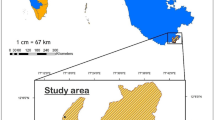Abstract
The obscure occurrence of the cottony-cushion scaleIcerya purchasi Maskell in its native country Australia is generally attributed to its natural enemies. Twelve natural-enemy-exclusion experiments were conducted at monthly intervals to confirm the role of natural enemies. Each experiment had uncaged, open-caged, and caged treatments. The natural enemies were active throughout the year. The percentage of scales surviving to adults in the cages was significantly higher than in the open-caged treatments, except the April (first) cohort. In both open-caged and uncaged treatments, the percentage of scales surviving to adults was similar and matched the changes in the numbers of natural enemies, thus confirming their importance in controllingI. purchasi in South Australia.
Résumé
On croit généralement que la Cochenille australienne,Icerya purchasi Maskell est originaire d'Australie d'où elle a été introduite dans différentes régions. Depuis 1888 les ennemis naturels de la Cochenille ont été introduits dans bien des pays avec des résultats appréciables. En Australie méridionale l'absence de la Cochenille est attribuée généralement à ses ennemis naturels, mais cette hypothèse n'a jamais été confirmée.
Douze expériences de suppression des ennemis naturels ont été conduites à un mois d'intervalle. Chaque expérience consistait à traiter une cage fermée, une cage ouverte et un emplacement qui en était dépourvu et ceci 3 fois. Des observations bimensuelles étaient pratiquées sur le nombre de Cochenilles survivantes et le nombre d'ennemis naturels présents. Les ennemis naturels étaient vivants toute l'année. Les pourcentages de Cochenilles atteignant le stade adulte étaient très bas dans les traitements des cages ouvertes et des emplacements vides, et coïncidaient avec les changements intervenus dans les nombres d'ennemis naturels. Les pourcentages de Cochenille atteignant le stade adulte étaient significativement plus élevés dans les traitements frappant les cages fermées, plutôt que dans ceux effectués sur les cages ouvertes, ceci dans tous les cas, à l'exception des premières cohortes d'avril. Les résultats confirment que la limitation naturelle des populations d'Icerya en Australie méridionale est due en grande partie à ses ennemis naturels.
Similar content being viewed by others
References
Bartlett, B. R. — 1978. Margarodidae. In: Introduced parasites and predators of Arthropod pests and weeds: a world review (C. P. Clausen, ed.). —USDA Agriculture Handbook, No. 480, 132–135.
Bennet, F. D. &Hughes, I. W. — 1959. Biological control of insect pests in Bermuda. —Bull. Entomol. Res., 50, 423–436.
Doutt, R.L. — 1964. The historical development of biological control. In: Biological control of insect pests and weeds (P. Debach, ed.) —Chapman & Hall, London, 21–42.
Debach, P. &Bartlett, B. R. — 1964. Methods of colonization, recovery and evaluation. In: Biological control of insect pests and weeds (P. Debach, ed.). —Chapman & Hall, London, 402–426.
Debach, P. &Huffaker, C. B. — 1971. Experimental techniques for evaluation of the effectiveness of natural enemies. In: Biological control (C. B. Huffaker ed.) —Plenum Press, New York, 113–139.
Debach, P., Huffaker, C.B. &MacPhee, A. W. — 1976. Evaluation of impact of natural enemies. In: Theory and practice of biological control (C. B. Huffaker &P. S. Messenger, eds.). —Academic Press, New York, San Francisco, London, 255–285.
Gonzalez, R. &Rojas, S. — 1966. Estudio analitico del control biologico de las plagas agricolas en Chile. —Agricultura Tecnica, 26, 133–147.
Hall, R. W., Ehler, L. E. &Bisabri-Ershadi, B. — 1980. Rate of success in classical biological control of arthropods. —Bull. Entomol. Soc. Am., 26, 111–114.
Quezada, J. R. &Debach, P. — 1973. Bioecological and population studies of the cottony-cushion scale,Icerya purchasi Mask., and its natural enemies,Rodolia cardinalis Mul. andCryptochaetum iceryae Will., in Southern California. —Hilgardia, 41, 631–638.
Author information
Authors and Affiliations
Rights and permissions
About this article
Cite this article
Prasad, Y.K. The role of natural enemies in controllingIcerya purchasi in South Australia. Entomophaga 34, 391–395 (1989). https://doi.org/10.1007/BF02372478
Received:
Accepted:
Issue Date:
DOI: https://doi.org/10.1007/BF02372478




